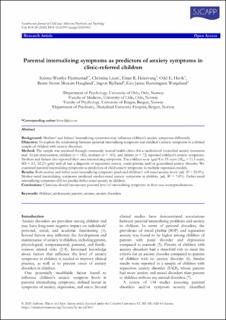| dc.contributor.author | Fjermestad, Krister | |
| dc.contributor.author | lium, christina | |
| dc.contributor.author | Heiervang, Einar | |
| dc.contributor.author | Havik, Odd E. | |
| dc.contributor.author | Haugland, Bente Storm Mowatt | |
| dc.contributor.author | Bjelland, Ingvar | |
| dc.contributor.author | Wergeland, Gro Janne | |
| dc.date.accessioned | 2021-03-03T12:06:18Z | |
| dc.date.available | 2021-03-03T12:06:18Z | |
| dc.date.created | 2020-11-17T23:39:22Z | |
| dc.date.issued | 2020 | |
| dc.Published | Scandinavian Journal of Child and Adolescent Psychiatry and Psychology. 2020, 8 18-24. | |
| dc.identifier.issn | 2245-8875 | |
| dc.identifier.uri | https://hdl.handle.net/11250/2731406 | |
| dc.description.abstract | Background:
Mothers’ and fathers’ internalizing symptoms may influence children’s anxiety symptoms differently.
Objective:
To explore the relationship between parental internalizing symptoms and children’s anxiety symptoms in a clinical sample of children with anxiety disorders.
Method:
The sample was recruited through community mental health clinics for a randomized controlled anxiety treatment trial. At pre-intervention, children (n = 182), mothers (n = 165), and fathers (n = 72) reported children’s anxiety symptoms. Mothers and fathers also reported their own internalizing symptoms. The children were aged 8 to 15 years (Mage = 11.5 years, SD = 2.1, 52.2% girls) and all had a diagnosis of separation anxiety, social phobia, and/or generalized anxiety disorder. We examined parental internalizing symptoms as predictors of child anxiety symptoms in multiple regression models.
Results:
Both mother and father rated internalizing symptoms predicted children’s self-rated anxiety levels (adj. R2 = 22.0%). Mother-rated internalizing symptoms predicted mother-rated anxiety symptoms in children (adj. R2 = 7.0%). Father-rated internalizing symptoms did not predict father-rated anxiety in children.
Conclusions:
Clinicians should incorporate parental level of internalizing symptoms in their case conceptualizations. | en_US |
| dc.language.iso | eng | en_US |
| dc.publisher | Psychiatric Research Unit | en_US |
| dc.rights | Attribution-NonCommercial-NoDerivatives 4.0 Internasjonal | * |
| dc.rights.uri | http://creativecommons.org/licenses/by-nc-nd/4.0/deed.no | * |
| dc.title | Parental internalizing symptoms as predictors of anxiety symptoms in clinic-referred children | en_US |
| dc.type | Journal article | en_US |
| dc.type | Peer reviewed | en_US |
| dc.description.version | publishedVersion | en_US |
| dc.rights.holder | Copyright 2020 The Authors. | en_US |
| cristin.ispublished | true | |
| cristin.fulltext | original | |
| cristin.qualitycode | 1 | |
| dc.identifier.doi | 10.21307/sjcapp-2020-003 | |
| dc.identifier.cristin | 1848981 | |
| dc.source.journal | Scandinavian Journal of Child and Adolescent Psychiatry and Psychology | en_US |
| dc.source.40 | 8 | |
| dc.source.pagenumber | 18-24 | en_US |
| dc.identifier.citation | Scandinavian Journal of Child and Adolescent Psychiatry and Psychology. 2020, 8, 18-24 | en_US |
| dc.source.volume | 8 | en_US |

